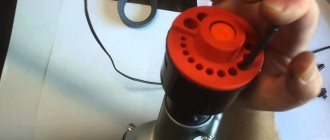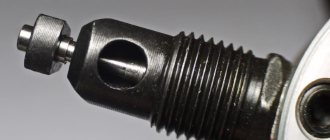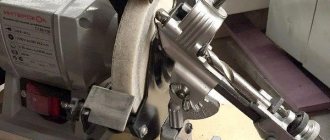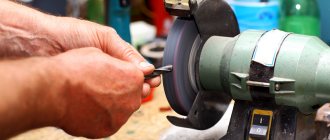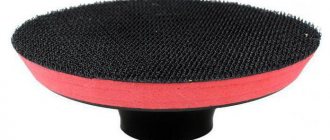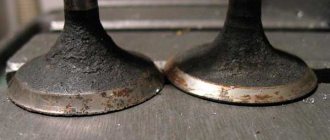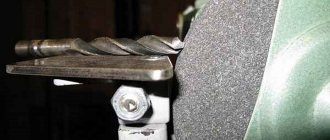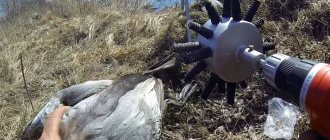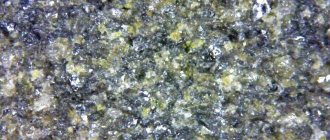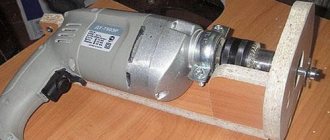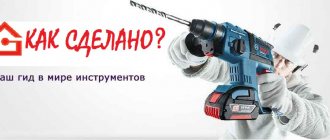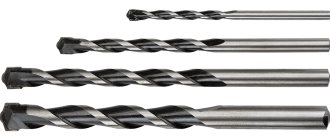Drills become dull quickly, and buying new ones each time is quite expensive. If you know a craftsman with a sharpening wheel, the problem can be easily solved, but not everyone is so lucky. To get your tools in order yourself, there is a special sharpening device - a drill attachment for sharpening drills, which is driven by the drill.
What is a drill attachment for sharpening drills?
It looks simple - a small device in a plastic case, inside of which a small grinding wheel rotates. It is installed in such a way that it creates an angle with the cutting edge at which sharpening of drills becomes possible.
There are holes along the body, the dimensions of each of them correspond to a certain diameter of the drill. Using a standard attachment, you can sharpen drills with diameters from 3.5 to 10 mm. The holes are arranged so that the drill comes into contact with the circle at the desired angle. The cutting edges are sharpened one by one, the second is sharpened after turning by 1,800. The drill attachment itself for sharpening drills is attached to the drill using a coupling. In this case, the chuck jaws close completely.
Advantages and disadvantages
Main disadvantages:
• Fragility, which is understandable, especially if you sharpen thoroughly dull edges. It is preferable to use it to straighten slightly sagging drills. • Weak fixation on the drill itself • Inability to change the parameters of the attachment itself - the sharpening angle does not change (changing the location of the sharpening stone on your own is a rather difficult process) • The coupling does not always fit the chuck; in this case, when rotating, it comes into contact with its inner surface. If possible, before purchasing, you should try on an attachment on a drill of the same class as the existing one. • You will have to immediately buy a bracket for fixing the drill. Otherwise, sharpening will be uncomfortable - holding the drill and turning the drill is inconvenient
Despite these shortcomings and inconveniences that arise when using the attachment, it is a fairly popular addition to the home craftsmen's toolkit. Especially when you consider that you can learn how to sharpen drills on the first try, and trips to the store for them will become much less frequent.
Metal drill sharpener
The design of this sharpener is simple and reliable. It consists of the following parts:
- Plastic case.
- A sharpening (abrasive) wheel inside the body, the shape of which allows you to make the correct sharpening angle.
- The body has holes into which drills (3.5-10 mm in diameter) are inserted for sharpening.
The circle rotates using an electric drill, the chuck of which is connected to the nozzle with a rubber coupling. The holes themselves, where the sharpened drills should be inserted, are made so that their cutting edge, when sharpening, contacts the wheel in the only correct position.
Procedure for sharpening:
- Insert the drill into the hole of the required diameter.
- Turn on the drill. Only one edge of the tool is sharpened.
- Then the drill should be rotated 180° and the other edge sharpened.
These operations must be repeated until the result is high-quality sharpening of both edges.
Important! The chuck jaws must be fully closed before installing the attachment. The use of a keyless chuck does not guarantee a completely reliable connection with the sharpening device.
Advantages and disadvantages of the device
Each device has its own advantages and disadvantages. And this drill attachment is no exception to the general rules.
The advantages include:
Does not require the user to be a sharpener. This device can be used by anyone without prior training.- Low price.
- Availability of spare abrasive wheel.
- In conditions of remoteness from the nearest workshop or garage where there is an electric sharpener, the value of this equipment is difficult to overestimate.
- When working at heights, when it is not possible to constantly go up and down to the place of work in order to sharpen a cutting tool somewhere, the value of this equipment increases.
Even an experienced mechanic, who has sharpened hundreds or even a thousand drills in his life, experiences difficulty sharpening any tool over the years, with his eyesight deteriorating. Of course, you can use glasses, but this is not always convenient in certain working conditions: altitude, frost (windows fog up), high humidity, etc. With this device, the use of glasses is reduced to a minimum.
Flaws:
- This device is not a professional tool and is not intended for workshop sharpening. Rather, it serves to straighten the cutting tool.
- The sharpening angle cannot be changed.
And yet, taking into account all the advantages, which outweigh the disadvantages, this equipment can be successfully used for its intended purpose.
Features of working with the tool
A feature of the standard attachment is that the holes for the drills are made so that the edges are next to the grinding wheel at a certain angle. There are also simplified options - without a regulating cover. They are simpler than a standard device, but they are not very convenient to use. You have to constantly monitor the correct position of the cutting edge and sharpening surface.
Anyone who has a drill at home can do the job of sharpening drills. The operating algorithm is simple and does not require any special skills:
• the drill is inserted into a hole corresponding to its diameter • after turning on the drill, the emery sharpening wheel begins to rotate, in the process one edge of the drill is sharpened • to sharpen the second cutting edge it must be rotated in the hole by 1,800
The drill is checked for readiness; if necessary, the sharpening process is repeated several times.
Material of manufacture and shape of nozzles
The design and material of drill attachments depends on the type of technological operations in which they are used. For cleaning and roughening surfaces, various types of brush attachments are used, and for preliminary grinding, flat or flap attachments based on coarse sandpaper are used. For fine grinding and polishing, fine-grained abrasives or non-woven materials are used. In the latter case, they are often used with grinding and polishing pastes and aerosols. When grinding requires the removal of a thick layer of material, including unevenly, various types of cutters made of hard abrasives based on aluminum and silicon compounds are used.
Disc and fan nozzles
The disc attachment for a drill consists of densely packed radial fibers diverging from the center of this tool. Depending on their purpose, fibers can be made from various materials. To remove rust and old paint, fibers made of steel wire 0.2 mm thick are used, and for grinding, fibers made of polymer materials are used. The working surface of such a tool is not only the horizontal plane, but also the side edge. Therefore, they are used for grinding narrow crevices and other hard-to-reach places.
Flap wheels are also used as attachments for drills. They consist of many identical strips of sanding paper, fixed at one end to the axis of rotation, resulting in the formation of a dense circular brush of abrasive lamellas. Due to their external similarity, such attachments are commonly called fan attachments.
Drum or cylindrical nozzles
Drum sanding attachments for drills consist of a cylindrical mandrel with a shank and sanding paper connected into a ring, which is put on this mandrel. Its drum is usually made of thick rubber or other elastic material. To prevent the sandpaper from coming off, a special mechanism is used. After putting on the sanding belt, the drum is deformed by tightening the nut on the shank and, increasing in radial size, tensions the belt. And to remove it, you need to loosen the nut and return the drum to its original state.
Drum attachments, along with end attachments, are very often used in fixed drills for grinding parts and dressing tools.
Plate attachment
A drill disc attachment is a plastic sanding disc with a cylindrical shank, to the outer surface of which a round sheet of abrasive is attached. The sanding sheet is fixed using Velcro, with a layer of soft elastic material most often located between the surface of the plate and the Velcro. It is necessary so that the abrasive sheet fits more tightly to the surface being treated and follows its profile, and also serves as a compensator when the drill deviates from the vertical axis. Without such a gasket, in case of any deviations from the vertical, the plate will cut one of its edges deep into the surface and create deep scratches on it. Therefore, rigid plates are mainly used for grinding in fixed drills. The thickness and material of the soft pad depend on the type and processing modes. For fine grinding or polishing, this can be a thick layer of ordinary foam rubber.
In addition to the usual ones, drill plates with a hinged shank are available. This solution makes it possible to reduce the thickness and increase the rigidity of the gasket.
Soft tips
In soft drill attachments, felt, felt, twisted threads, woven materials and foam rubber are used as working materials. As a rule, such a tool is used for polishing metal, wood and paint coatings, including polishing pastes and suspensions. Soft nozzles have the shape of a disk, ball, cylinder and are attached to the shank with two pressure washers. One of the most common examples of their use in everyday life is polishing the paintwork of cars using a drill and foam discs.
End bits
Abrasive end attachments for drills are one of the types of cutters - a metalworking tool that is used for manual grinding of profile surfaces, widening holes and removing excess metal in hard-to-reach places. This cutter is a cylindrical shank with an abrasive head pressed onto the front end of it. And the name “end” is due to the fact that processing with such a tool is most often performed in a perpendicular direction. End attachments are available with a wide variety of heads: round, conical, cylindrical, parabolic, etc. Therefore, you can always choose a cutter whose geometry best matches the profile being processed. The material used for abrasive heads is various types of high-hardness sandstone. In a fixed drill, cylindrical cutters can be used to sharpen metalworking tools.
How to choose the right one, scope of application
The average cost of a sharpening device is no more than a thousand rubles. As mentioned above, before purchasing, you should check the compatibility of the purchased device with the drill for which it is purchased. At the very least, you should measure the bore diameter in advance, but it is better to check directly on the tool. The store will probably have a drill model similar to the one you have.
Some accessory models come with spare grinding wheels. This is convenient and will extend the life of the nozzle. When using the attachment, you should remember that this is not a professional sharpening machine. Initially, this prefabricated structure is not designed for heavy loads.
There are three types of nozzles:
• for circular saws • for drills • for plane and chisel blades
The demand for such attachments is not a random phenomenon. Professional sharpening by craftsmen with special tools is quite expensive, and the presence in the house of such additions to the drill, which everyone has, ensures the ideal condition of all cutting surfaces and edges.
The attachment should be selected in accordance with the drill model. You can pay attention to devices from well-known companies. Many power tool manufacturers produce similar devices that are ideal not only for their products, but also for drills from other companies. The best option is when the attachment comes with the drill itself. Before purchasing, you need to decide on the type of sharpening required and the diameters of the drills that are most often used, so that the use of the attachment is as effective as possible.
How to work with attachments
When using drill attachments, it is recommended to adhere to the following rules.
- The workpiece that is planned to be processed should be securely fixed.
- When working on walls, you need to make sure that there is no wiring in its plane.
- The nozzle is firmly fixed into the cartridge so that it does not fly off during operation.
- It is recommended to regulate the pressure of the drill while passing the equipment along the working surface.
- When processing wood, the tool is held with both hands. This caution is especially important when using a powerful device.
- You cannot switch the reverse mode until the rotation is complete.
- When working with a drill, personal protective equipment should be used. The skin should be covered as much as possible with clothing and gloves. To prevent splinters from getting into your eyes, use construction goggles. Stripping and polishing is performed using earplugs or headphones to reduce the impact of noise on the hearing organs. The respiratory tract is protected with a special mask or respirator.
- After turning off the drill, allow the attachment to cool for some time. Therefore, it is not recommended to touch it immediately due to the risk of getting burned.
The drill is not designed for heavy loads. When processing materials with a solid structure, this fact must be taken into account. The instrument should be given time to rest and cool down. It is recommended to use special milling equipment for carbide workpieces.
Accessories, spare parts
The best option to buy is an attachment with spare sharpening stones. If possible, you should purchase a bracket for fixing the drill - this will greatly facilitate the task, especially if sharpening will be done regularly. Each device comes with instructions that will make it easier to learn the new function of the tool. A regular grinding wheel is designed for several dozen operating cycles, so you can calculate the expected load and buy components according to plan.
Review of wood drill attachments: drills and bits
Drilling holes is the main function of a drill, for which there is a huge selection of removable devices, presented individually or in the form of entire sets. The most common types of nozzles used for these purposes:
- Forstner drills;
- crowns;
- feather drills.
Related article:
Metal crown: types, sizes, methods of application
Technical design and method of application. Types of cutting edge. Drilling attachments Bosch, Enkor, Zubr, Fit. Correct use of the tool.
A Forstner drill has wide cutting surfaces located on the sides. A point is provided to center this tip. This type of nozzle is used to form medium and small sized holes in wood. In this case, the tip does not pass through the material. The presence of a tip allows you to achieve high precision when creating holes for mounting hinges.
Feather drills are designed to make wide holes, the diameter of which can reach 6 cm. These attachments make it possible to install fittings in slab materials made of wood and even in solid wood. Such drills are equipped with wide side feathers and a centering point. This flat-shape design produces a precise recess while limiting the depth of the hole.
The Forstner drill bit is suitable for creating small and medium-sized holes in wood
Crowns are attachments with a complex design designed for sampling material. The cutting surface of these tips has a characteristic profile, it is wide and has a high margin of safety. Crowns work on the principle of an incisor, and in some cases, several incisors. They are used to create holes, the diameter of which can reach 10 cm. A drill is installed in the center of the tip. It sets the first hole, which centers and guides the nozzle. Crowns can be used not only on wood (fibreboard, chipboard, solid wood), but also on metal and concrete.
Note! When choosing any type of attachment, you must take into account the size of the electric drill chuck on which it will be installed.
Depending on the configuration, drills can be used as drill attachments for concrete, wood and metal. Tips with a high safety margin are called pobedit tips. This group of devices includes attachments designed for impact and vibration equipment.
